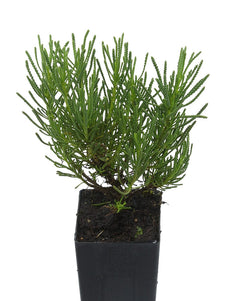
Santolina Green
Santolina Green

- Low stock - 15 items left
- Inventory on the way

Usually available: All year
Life cycle: Perennial
Height: 30cm
Position: Full sun
Soil preference: Well drained
This is how we pack and send your Herb Plants to all states except TAS & WA
You will receive
- 1 Santolina Green Herb Plant in a 50 X 75mm tube - General growing instructions
All of our Herb Plants are grown organically with certified organic potting mixes and fertilizers
Botanical Name: Santolina virens
Santolina Green is an evergreen shrub with a compact, mounding growth habit reaching 30 cm high and up to 75 cm wide. The deep green leaves are narrow and pinnately divided, creating an impression of cypress pine foliage. They are highly aromatic and have a pungent menthol or pine like fragrance. The narrow leaves are held on small branching stems that become woody as the plant ages. The yellow flowers appear in summer and consist of small and button-like composite flower heads, held on slender stems from 10-25cm above the foliage.
Santolina Green has the botanical name Santolina virens and is found in the Asteraceae family of plants. There are from 5-24 plants in the Santolina genus, according to various authorities. Other plants in this genus may also be called Santolina Green, so it is best to check the botanical name to be sure. This plant may also be called Green Lavender Cotton, Ground Cypress or similar, due to the leaves resembling the type found on lavender or cypress plants. However, the Santolina genus has no relationship to these plants. The native habitat for Santolina Green is in the Mediterranean, including Spain and France, known for dry and scrubby conditions.
Santolina Green is highly ornamental and is often used in rockeries, garden borders or as a small hedging plant. It is more compact than Santolina Grey and slightly less hardy.
Growing Conditions
Santolina Green prefers full sun but may tolerate a small amount of shade. Generally it does well in poor, dry soils that are well drained such as sandy soil or rockeries. However, most soils including a small amount of clay should be acceptable. It should be drought tolerant and frost hardy once established and shows some degree of salt tolerance, so coastal planting is suitable. Overwatering or humidity will cause fungus to grow and may result in the death of the plant.
As the plant ages, the woody stems in the centre of the plant may split and create an open space. Keep the plant trimmed to maintain density with new growth and avoid this issue. Many gardeners use this as a hedging plant and forgo the yellow flowers which only appear on second year growth. To propagate use semi hardwood cuttings during summer and autumn, divide plants or collect and plant seed after providing the chilling requirements.
Culinary Uses
Although there is no real history of culinary use for Santolina Green, the leaves may be used sparingly for flavouring dishes in a manner similar to Santolina Grey.
Medicinal Uses
Santolina Green does not appear to have a strong history of medicinal use. However, Santolina Grey does have some historical background which may be of interest.
If the leaves are crushed they may cause a skin rash or allergic reaction.
Other Uses
The flowers and branches of Santolina Green dry well and may be used in dried arrangements, wreaths or potpourri – much like Santolina Grey. The pine-menthol fragranced leaves have a history of use as insect repellents.
All information provided on this website is for informational purposes only. Please seek professional advice before commencing any treatment.




